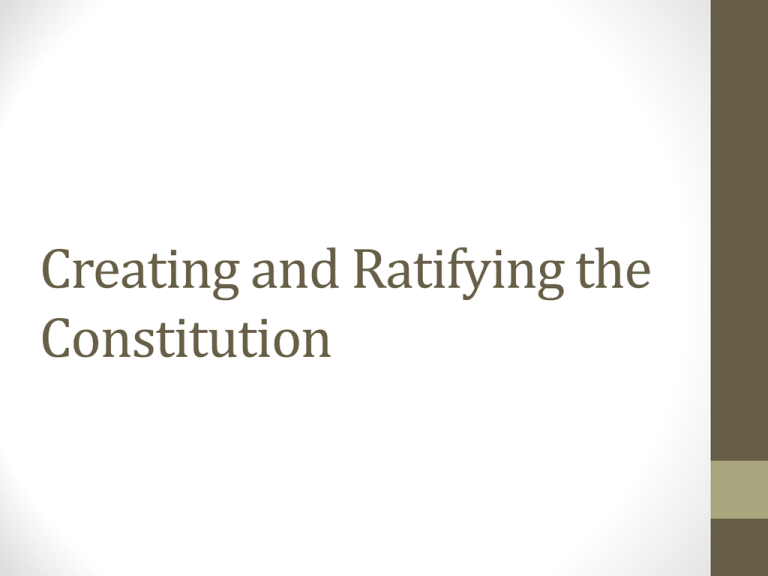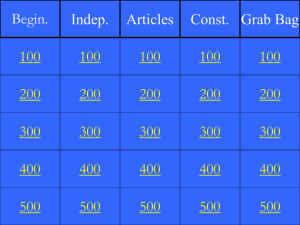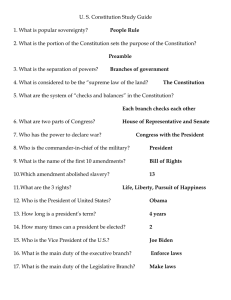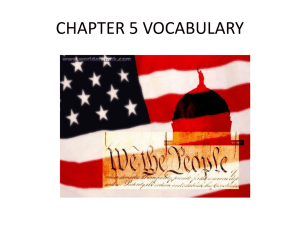The Constitution: Continued
advertisement

Creating and Ratifying the Constitution A key to success! • The Constitution is able to adapt to the changing times! • The Constitution is the highest authority in the nation! The Virginia Plan •Mostly designed by Madison Described a government with a president, courts, and a two house congress •Representation in Congress would be based on the state’s population The New Jersey Plan • Called for a government similar to the Articles of Confederation • One House of Congress with equal representation to all states • Venn Diagram to compare and contrast the two plans. The Great Compromise • Suggested by the Connecticut delegates • Two houses of Congress • One house- equal representation, the other- representation based on population 3/5ths Compromise • Compromise on slavery for representation and taxation • Southern states wanted slaves counted as part of the states population • Northern states opposed the idea • Compromised to count the slaves as 3/5ths of other persons The Commerce and Slave Trade Compromise • Northern states felt that Congress should regulate trade with other countries • Southern states feared that Congress would use the power to tax exports and interfere with the slave trade (They were split) • Compromise: Congress would regulate trade, but could not interfere with the slave trade for 20 years nor tax exports (Slavery was put off) • Exports- goods sold to other countries The Electoral College • Compromise on the selection process of the President • Some delegates thought Congress should choose the President/ others thought elected by the people • Each state legislature would choose a number of electors (today: electors are elected) • The electors select the President & the Vice President • Larger states have more influence • The delegates sign the Constitution on September 17, 1787 Discussion • Do you agree with the Electoral College electing the President/Vice President? Why? Activity • You will work on a worksheet called “The Compromise”. Ratification of the Constitution • Constitution would become law when ratified by 9 of the 13 states Anti-Federalists • Openly opposed the Constitution • Felt too much power was given to the federal government • Lacked a Bill of Rights: no provision for basic liberties (freedom of speech) Federalists • Supported the Constitution • Many helped write the Constitution • Argued that a nation would not survive with out a strong central government • Argument supported by the failure of the Articles of Confederation • Their objective was to increase public support for the Constitution • “The Federalists” papers written by Madison, Alexander Hamilton, and John Jay, defended the Constitution • Agreed with the Anti-Federalists that a Bill of Rights was needed -promised that if Constitution was ratified, Bill of Rights would be added This is where the 1st Political Parties were formed. Ratification • Promise by the Federalists encouraged New Hampshire, the 9th state, to ratify in June, 1788 • Constitution becomes law • In time, all states ratify, with Rhode Island being the last in 1790 The Federalist #10 • Authored by James Madison • This essay, the first of Madison's contributions to the series, was a rather long development of the theme that a wellconstructed union would break and control the violence of faction, a "dangerous vice" in popular governments. • He had two ways to fix this problem: • Get rid of factions (why wouldn’t this work?) • Control the factions (Would this be hard to do?) • But the main solution was to: • Have as many factions a possible so that no faction would be big enough to overthrow the government Activity • You will be given the Federalist Papers #10 to read and answer the following questions: • What is the content about? • What is the overall message? • What is being talked about? • Read the highlighted sections and answer the following: • • • • • What does it mean? Why was the word party used? How does the word party connect with the word factions? What information has been added here that connects with rivals? How does this document connect with the principles of the American government? Activity continued…. • Read the 2nd highlighted section and answer the questions: • Does that make sense? • Is this explained clearly? Why or why not? • What do we need to figure out or find out?







